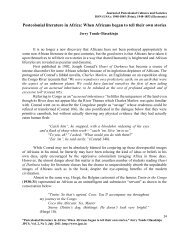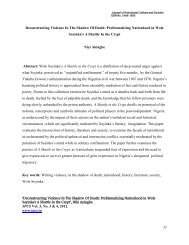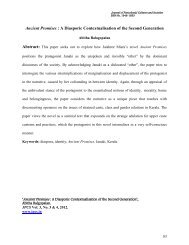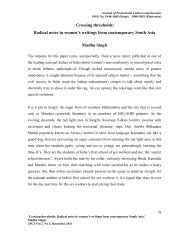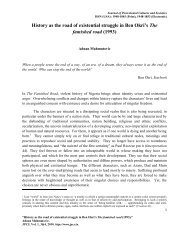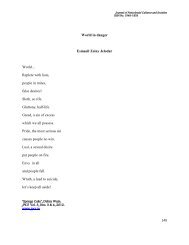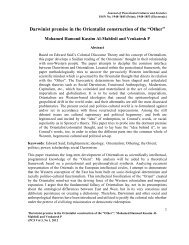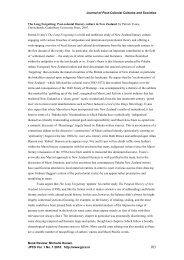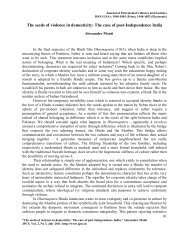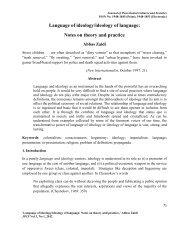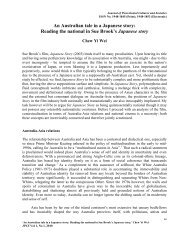Contemporary English Writing in India - JPCS
Contemporary English Writing in India - JPCS
Contemporary English Writing in India - JPCS
Create successful ePaper yourself
Turn your PDF publications into a flip-book with our unique Google optimized e-Paper software.
Journal of Postcolonial Cultures and Societies<br />
ISSN No. 1948-1845 (Pr<strong>in</strong>t); 1948-1853 (Electronic)<br />
Internet?) and also difficult to simply exclusively associate their writ<strong>in</strong>gs with their cultural<br />
background, as if they were liv<strong>in</strong>g <strong>in</strong> a plastic bubble. In this sense, this issue of the Journal of<br />
Post-Colonial Cultures and Societies has attempted to provide a space for discussion and<br />
analysis that helps to deepen our current understand<strong>in</strong>g of contemporary <strong>English</strong> writ<strong>in</strong>g <strong>in</strong> <strong>India</strong><br />
through a variety of critical stances.<br />
Yet, the preparation of this volume has given rise to coexist<strong>in</strong>g oppos<strong>in</strong>g forces. The<br />
whole message and core idea that contemporary <strong>English</strong> writ<strong>in</strong>g <strong>in</strong> <strong>India</strong> deserved special<br />
attention was utterly buried by the avalanche of essays deal<strong>in</strong>g with some of the abovementioned<br />
authors. This was a sign of the great attention attracted by the literary quality of such<br />
writers and the scarce <strong>in</strong>terest on the part of the academia to <strong>India</strong>n writers liv<strong>in</strong>g <strong>in</strong> <strong>India</strong>.<br />
However, those few accepted papers (four out of only eight received) engage with connections<br />
between history, economics, literature, society, religion, and so on. Indeed, these articles devote<br />
to the analysis of how contemporary <strong>India</strong>n writers deal with cultural and social problems or<br />
<strong>India</strong>n public issues through literature. This approximation may offer an illum<strong>in</strong>at<strong>in</strong>g perspective<br />
complementary to that other more common approach that one usually encounters.<br />
The reason why literature written <strong>in</strong> <strong>English</strong> by <strong>India</strong>n authors liv<strong>in</strong>g <strong>in</strong> <strong>India</strong> does not<br />
receive an equal amount of <strong>in</strong>terest may possibly thus lie <strong>in</strong> a dom<strong>in</strong>ant Westernized critical<br />
approach. It is quite strik<strong>in</strong>g to f<strong>in</strong>d out that all the authors contribut<strong>in</strong>g to this issue have <strong>India</strong>n<br />
names. Hence my statement po<strong>in</strong>t<strong>in</strong>g out that a Westernized critical approach may have had<br />
someth<strong>in</strong>g to do with this situation. It can be a symptom of the biased stance <strong>in</strong> Western<br />
academia but also a proof of the difficulty of approach<strong>in</strong>g an utterly different cultural paradigm,<br />
not to mention historical, sociological, literary or l<strong>in</strong>guistic, from one’s own. Be that as it may, I<br />
Editorial. Crist<strong>in</strong>a M. Gámez-Fernández. <strong>JPCS</strong>. Vol. 3, No. 2, 2012.<br />
2



